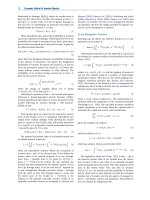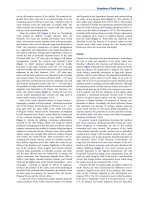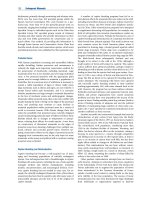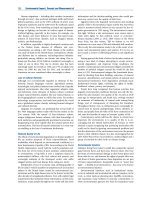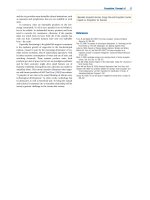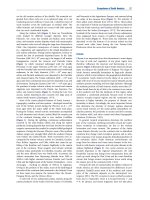Encyclopedia of biodiversity encyclopedia of biodiversity, (7 volume set) ( PDFDrive ) 3192
Bạn đang xem bản rút gọn của tài liệu. Xem và tải ngay bản đầy đủ của tài liệu tại đây (59.54 KB, 1 trang )
Marine Mammals, Extinctions of
superficially similar to the modern sea lions and fur seals. All
known odobenid fossils have been found in the northern
hemisphere. The odobenids seem to have diverged from the
otariids in the early Miocene. Peak fossil diversity is in strata
from the late Miocene and early Pliocene. Diversity declined
abruptly during the late Pliocene and Pleistocene. The single
surviving species, the modern walrus, appeared in the fossil
record during the Pleistocene. Extinct odobenids were also
broadly distributed across latitude. The modern walrus is
limited to high northern latitudes and is distributed aberrantly
relative to the extinct odobenids.
The fossil record indicates that modern walruses are the
single relict of a largely lost taxon. Most extinctions of odobenids seem to be associated with global-scale cooling and related
large-scale habitat change during the Pliocene. However, ecological characteristics of the extinct odobenids are in many cases
difficult to understand because the surviving contemporary
model seems aberrant. Thus, it is difficult to develop meaningful functional models of extinction in the odobenids.
Sirenia
Sirenian diversity clearly peaked during the Miocene, a period
of warm global climate coincident with extensive warm shallow coastal marine habitats. The dugongids, now represented
by a single surviving species, were the most diverse family of
sirenians through the fossil record. Sirenian diversity declined
sharply during the relatively cool Pliocene and Pleistocene,
and modern forms are relicts of a largely extinct order. Two of
four recognized sirenian families are now fully extinct.
Unlike the odobenids, the surviving sirenians seem to
provide good ecological models for the extinct forms. Modern
sirenians typically consume macrophytes in shallow waters
and clearly prefer warm protected waters. Thus, it is likely that
Pliocene cooling and the coincident widespread loss of warm
shallow seas were major factors in the decline of the sirenia.
Surviving species were those able to retreat to low-latitude
refugia or, in the case of the Steller’s sea cow, a subpolar refuge
with abundant food and apparently with no significant
predators.
Desmostylia
Desmostylians did not diversify to nearly the extent of the
other major marine mammal taxa, and did not survive beyond
the end of the Miocene. Lacking modern ecological models,
we prefer not to speculate on specific ecological mechanisms
of extinction in the desmostylians. However, loss of the taxon
coincided in time with the decline of sirenians, with which
desmostylians share common ancestry. Thus habitat needs
and associations may have been similar between late Miocene
sirenians and desmostylians, and loss of optimal habitats
during Pliocene cooling could have had similar effects on both
groups.
Modern Anthropogenic Extinctions of Species, Subspecies,
and Major Populations
Species Level
Following the taxonomic format of Rice (1998), four species
of Holocene marine mammals are known to be extinct. In all
75
cases the probable causes were anthropogenic. In addition,
Rice (1998) reports anecdotal evidence from non-technical
sources that a recent species of pinniped, undescribed and
entirely unknown to science, once occurred in the Chagos
Archipelago and Seychelles Islands of the tropical southwestern Indian Ocean. If such a species occurred it is now
extinct as a result of unknown factors.
Baiji (Yangtze River Dolphin): Lipotes vexillifer Miller, 1918
The baiji, also known as the Yangtze River dolphin or Chinese
River dolphin, was the sole known member of the family
lipotidae. The baiji dwelled exclusively in fresh water habitats
of the middle and lower Yangtze River (from Yichang eastward
to the river mouth at Shanghai) and the adjacent Qiantang
River in southeastern China. Accounts of population surveys
are summarized by Turvey et al. (2007). The baiji had been
recognized as imperiled for a number of decades. Baiji were
not seen in the Qiantang River after the 1950s. Surveys of baiji
habitat in the Yangtze River in the late 1970s suggested a
population of 400 individuals. By the middle 1990s population estimates were less than 100 animals. The last authenticated observation of a live free-ranging baiji was in 2002.
Turvey et al. reported the results of a combined intensive
survey of the entire known range of the species in 2006 using
multiple vessels and visual and acoustic survey methods. No
animals were located and the baiji appears to be extinct in all
known native habitats. There are no living baiji in captivity.
Likely causes for the loss of the baiji include high rates of
bycatch in fishing gear, erosion of environmental quality due
to dam construction and industrial pollution, and shipstrikes.
Turvey et al. suggest that fishery bycatch was the predominant
risk factor contributing to apparent extinction. Bycatch intensity probably correlated directly with the extreme density of
the human populations, and associated high demand for
dietary protein, in the Yangtze watershed. The region was
home to roughly 650 million people at the time of the baiji
survey in 2006, approximately 10% of the earth’s human
population. The intensive industrialization of the Yangtze region, and the obviously diminished air and water quality
characteristic of the area, likely contributed to loss of the baiji
as well.
Caribbean Monk Seal: Monachus tropicalis (Gray, 1850)
The Caribbean monk seal was one of three recent species of
Monachus. All occur or occurred in tropical or subtropical
latitudes. The pre-exploitation range of M. tropicalis included
the islands of the Caribbean Sea, the coastal regions of
Venezuela and Caribbean Colombia, southern Florida, the
east coast of Mexico south of the Bay of Campeche, and the
Caribbean coasts of Belize, Guatemala, Honduras, Nicaragua,
Costa Rica, and Panama. Estimates of pre-exploitation population sizes are not available. Intensive hunting of seals for
meat and oil began soon after arrival of European explorers in
the late fifteenth century. Seal populations were reported as
depleted as early as the seventeenth century, but a few animals
survived into the middle twentieth century. The last confirmed
sighting of a Caribbean monk seal was at Seranilla Bank, west
of Jamaica, in 1952. Directed surveys for seals in the later
1950s and 1960s found no living animals.
